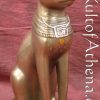Bastet was a long-worshipped and popular god in the ancient Egyptian pantheon. Originally a lion-headed woman and the Goddess of Warfare of Lower Egypt, she evolved into being a Goddess of fertility, of protective motherhood, and magical ointments, particularly those used in the embalming rituals. With this evolution of roles, her portrayal altered from half-feline-half woman, to being represented wholly by the domestic cat.
The Egyptians kept cats as pets, particularly for the rodent-and-snake-control talents – more than just pets however, all cats were regarded as the sacred animals of Bastet, and thus given respect and a degree of worship similar to that afforded to the cow in modern India. Some Royal cats even wore expensive jewelry and could eat from the same plate as their owners. If this was custom among the higher classes, then it is likely that the lower classes would emulate this custom.
This cultural respect is evidenced by the prevalence of cat mummies, of which more than 300,000 were uncovered at Bastets central temple at Per-Bast. There were even mummified cat owners there, who were entombed alongside their cats. In several other sites, such as Saqqara and Beni Hasan, cat mummies in the hundreds of thousands were found.
Mummification was an expensive and time-consuming process – the care taken in providing for the afterlife of cats reflects their status within their families. A Greek observer noted that houses would go into mourning at the death of a cat, with the same sadness afforded a deceased child. After wrapping the cat in fine linens, its journeys to embalming and to its final entombment may have included a funerary procession, complete with wailing mourners. The wealthiest cat owners even had detailed wooden mummy cases, some of which were gilded with bronze or gold and placed within stone sarcophagi.
While beginning as a Goddess of warfare, in time Bastet was depicted as being married to Anubis, the god principally involved in mummification. Thus Bastet was regarded as a Goddess of the protective, and magical ointments and perfumes used not only in daily use, but also in the embalming process. The natural ability of cats to mother entire litters and defend her kittens caused Bast to also be regarded as a fierce motherhood goddess. Ambitious mothers-to-be might wear magical amulets depicting kittens – their number corresponding to the number of children desired.
This statue of Bastet is made of cast resin and is finished in bronze with painted detailing.










Reviews
There are no reviews yet.